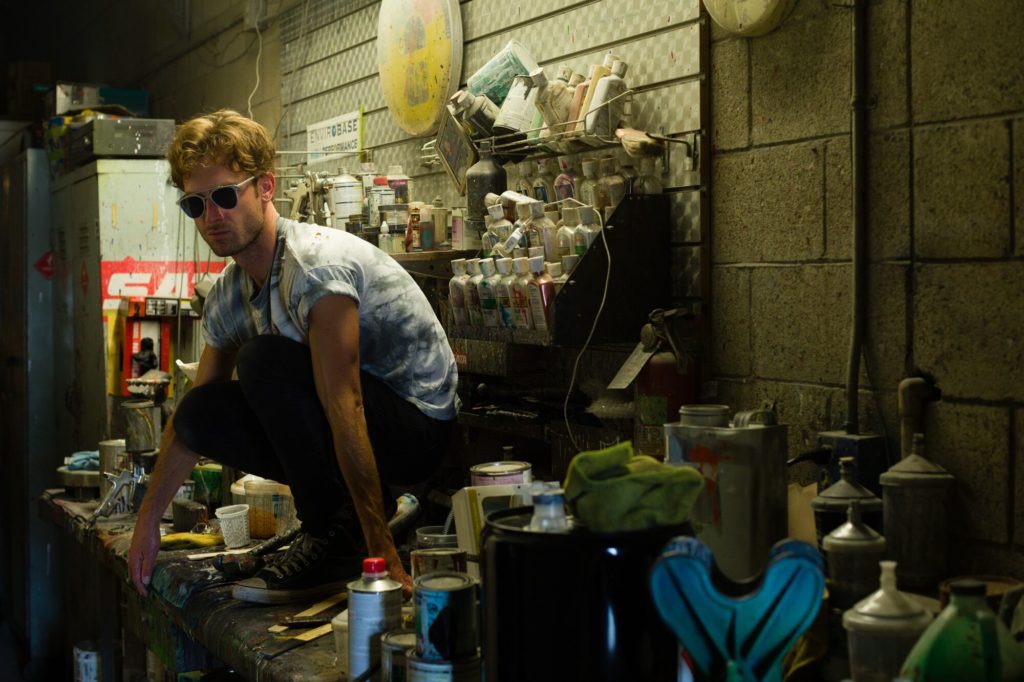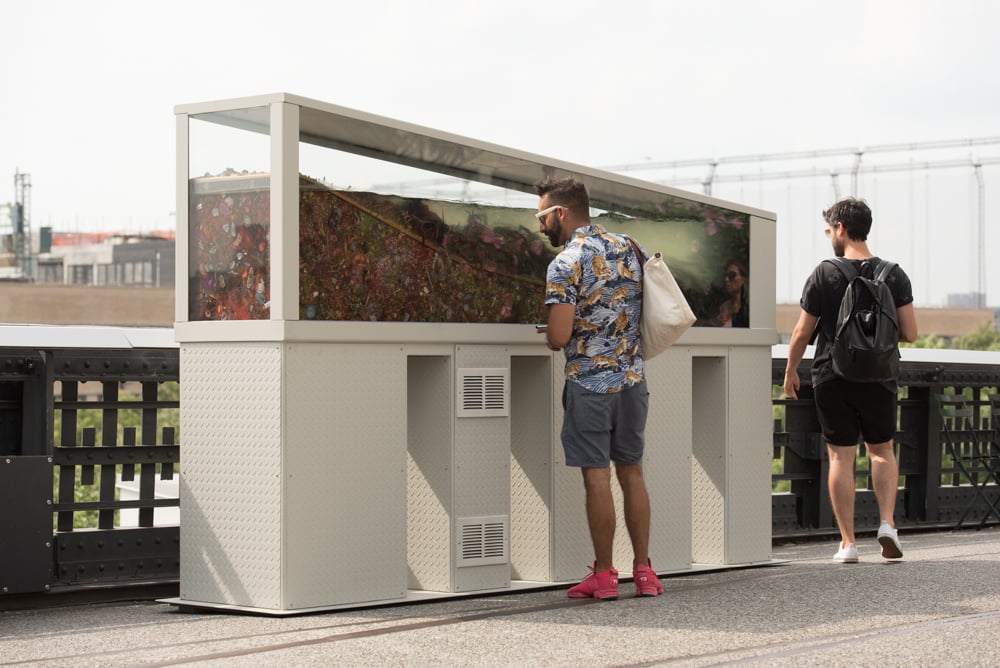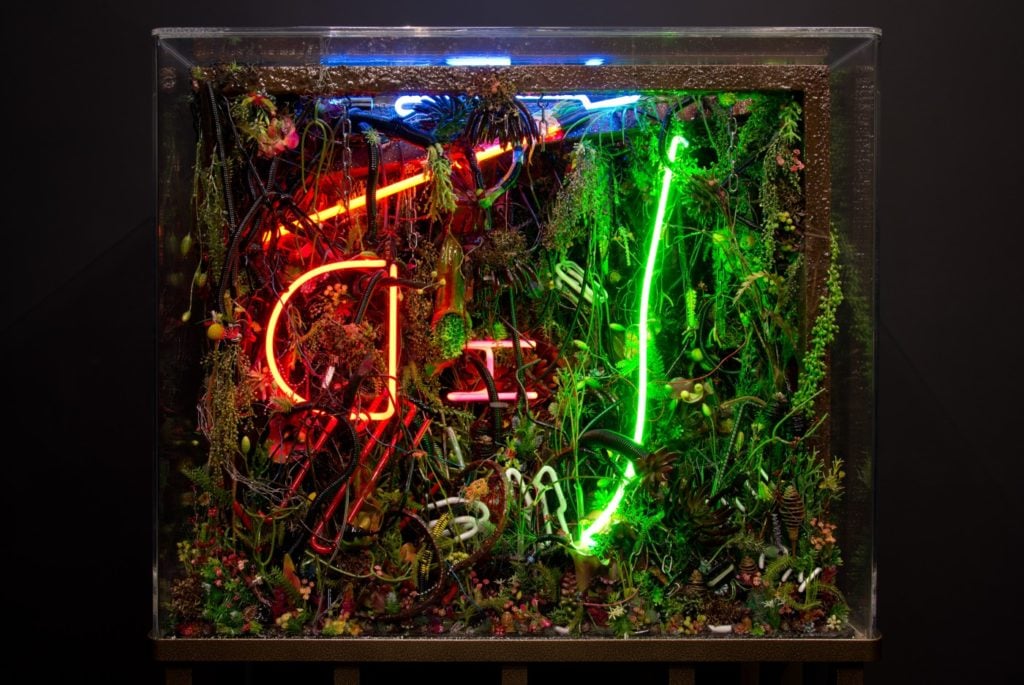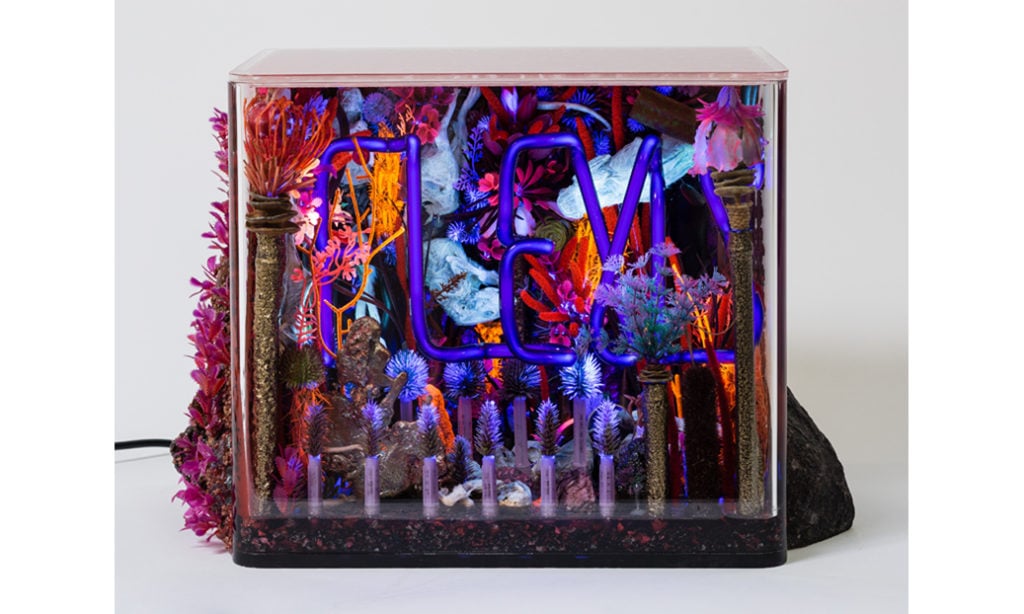Art World
‘We as a Species Are Selectively Alarmist’: Artist Max Hooper Schneider on Why He’s No Mad Scientist
The LA-based sculptor makes high-concept dystopian terrariums, some of which are potentially deadly.

The LA-based sculptor makes high-concept dystopian terrariums, some of which are potentially deadly.

Henri Neuendorf

Max Hooper Schneider creates environments contained in terrariums and aquariums, blending biological and synthetic ephemera with aquatic and plant life. Often these works manifest themselves in dystopian-looking dioramas that could just as well have been produced by a mad scientist in a biology lab as by an artist in the studio.
One of these works is currently on view as part of the show “Mutations” on New York’s High Line, a large swirling aquarium that resembles an underwater film set from an ’80s sci-fi movie. It’s filled with natural artifacts such as crystals and gemstones as well as random bits and pieces including razor blades, keys from a keyboard, a necklace, rubber bands, and surgical scalpels.
To understand Hooper Schneider’s work requires a look back at his unusual path to his present art career. The 35-year-old artist studied biology and urban design at New York University, followed by a master’s degree in landscape architecture at Harvard. After completing these studies, he cut his teeth as a project coordinator in the studio of French artist Pierre Huyghe before his breakthrough exhibition at the Los Angeles gallery Jenny’s in 2014 launched his solo career. Since then he’s had solo shows at LA’s Kayne Griffin Corcoran in 2015 and Paris’s High Art.

Max Hooper Schneider Section of Intertidal Landscape (Hair Metastasis (2017). Photo: courtesy of High Line Art.
With Hooper Schneider on the cusp the cusp of stardom, we asked him about how he blends art and biology, his meteoric rise, and how he balances his unwieldy art with the market’s demands. (Editor’s Note: Hooper Schneider choose to reply by email, which we present here in full.)
How did you turn an education in biology, urban design, and landscape architecture into an art career?
It is more accurate to say that I was turned. Retrospect produces an autobiography of inevitability or willed intention. In my case pluralistic interests gradually accreted a career in art. I explored things to which I was drawn—material technologies, living systems, biological fieldwork, theory, architecture, literature, and so forth—and sought degrees that afforded me the largest ateliers for doing so. On the other hand, when I thought about a vocation I never imagined a terminus other than art. This way of proceeding allowed me to amass knowledges and skill sets that have served me well. But it was a lengthy, nonlinear, non-teleological process. It was only after matriculating from Harvard that I began to single-mindedly pursue a career in art—although “career” still rings less true than “obsession.” My aesthetic interests remain rooted in their original sources but also continue to diversify. This dynamic means that every work is an experiment. It is my understanding that an artist becomes more variegated, more sagacious, as he or she researches and incubates new bodies of work.
What is it about biology and the natural environment that fascinates you?
“Biology” and “natural environment” are disciplinary constructs that produce fields of study for applied or vocational purposes and are not reflective of any other reality. I think of biology, and nature, in the Spinozan sense of everything that is. Architecture is biology, art is biology, the dead skin cells currently forming a microsoil in my computer keypad is biology. A plastic toy is as natural as a tide pool and given enough time the tide pool will become the plastic toy and vice versa. I’ve seen it happen and execute such transformations in my work. I observe nature and generalize it as such: climaxes, the carrying capacities and breakdowns of identifiable systems, reversals, events presumed to be impossible, and cycles, the return to a known beginning or genesis, and the Umwelten human and nonhuman communities form around these processes. Biology is just another language for communicating a worldview or worldviews and I often, but never exclusively, choose to frame my work within derivations of this language. There is something indifferent and sleek, and yet perversely humorous, about the technicality of the biological patois. Do we say a creature is “apiverous” or has a diet consisting of bees? My verdict is split. Because part of my fascination with nature is concerned with mutation, hybridity, and succession, and because there is a rich scientific literature on these topics, I frequently deploy its vocabulary in my work. But as I said before, I am the product of, and draw upon, so many disciplines that I refuse to lionize one over the other.

Max Hooper Schneider The Extinction of Neon 2 (2015). Photo: courtesy High Art, Paris.
What are your earliest memories of art?
This could be an instance of retrospective reimagining but I’m going to say it was an amalgam of several childhood obsessions: zoological field guides; the modeled habitats of aquaria; and traditional Japanese craft, namely woodblock printing, calligraphy, ikebana, and bonsai. With field guides, I loved, and still love, finding the moments of fanciful articulation in what were supposed to be objective representations of organisms. That extra lash, the shiny carapace, the foreshortened antenna. This suggested a failure of science, a breakdown of information, a place where storytelling begins. In modeling aquaria I was fascinated early on by the romanticism and dramaturgy surrounding artificial habitats housing the pet or specimen. Everyone loves a miniature. Oftentimes in my dilettantish menageries, one could find tanks featuring fetishized biomes devoid of animal or plant matter. I enjoyed the art of overriding the aura surrounding the rare or prized fish or reptile. Without continuing to ramble, the tightness, fertile minimalism, and, above all, animism inherent in traditional Japanese craft and design was an immediate draw: the tension between reverence for raw, organic, and earthen materials and simultaneously their subjugation—an intersection of the clinical and the poetic. I carry this tension with me today.
You were still working for Pierre Hyughe when you had your breakthrough show at Jenny’s in 2014. Why do you think the show was so well received? Why do you think people responded so well?
This feels a bit like a question with unstated implications, which makes it somewhat difficult to answer. Let me state that I have unreserved respect and admiration for Pierre’s work as well as a fondness for the person. My show at Jenny’s in 2014, however, did not derive from his artistic ecosystem. It was just a bountiful epoch for everyone and a coincidence of timing. I had recently moved back to Los Angeles and was assisting his studio with the install at LACMA. Around this time I also was preparing to release works that had been conceptualized years before and by that time were like holograms waiting to be materialized. I made the show with a narrow audience in mind and had absolutely no idea that anything would come of it. I can’t tell you why “The Pound” was well received. I heard it was polarizing. Anyway, I made a world and articulated the matters that populated that world. Personally I wanted to feel like I had walked into something, that I could be impounded or become the subject of nefarious study in the same way my sculptures stood captive. It was a democratic plane. I look forward to my 2018 show there.

Max Hooper Schneider, Pet Semiosis 8: FLEAS (English). Courtesy of High Line Art/photographer Michael Underwood.
You’ve been described as being more of a biologist than an artist. Do you think that’s an accurate assessment?
I prefer to let the works speak for themselves—particularly since different observers will have different opinions and interpretations. But, since I am not only one of these observers but the producer, I will provide my interpretation, which has two facets. One, as I mentioned earlier, everything is biology, everything is nature. This means that I am indeed a biologist in my manipulation of biological materials—or, together, we are a biological event; and two, I do not think of myself as a biologist and would never claim to be a biologist by training. I wish I had matriculated far enough in the sciences to make such a claim. Perhaps in the future.
A lot of your work revolves around keeping environments within containers. What is it about using aquarium or terrariums that interests you?
At the forefront of my practice is the question: “What is containment?” It surely must include cognitive as well as haptic and structural meanings. Whether its an aquarium, terrarium, paludarium, refugium, house, resort, hospital, summer camp, Marxism, Monism, or Scientology. We all find the containers that suit us best. It is fair to say I find that transparent containers serve as perfect stages for specimen encasement and biological reenactment that foster the production of a universe or the dioramic mis-en-scéne. But I also view the aquarium, the container, just as much as an outside or as a surface for externalization. It is open within, and as a constituent part of, the space-time continuum. Because an object has the ability to hold something does not diminish its ability to enter into a structural or vibrational intercourse with its surrounding context. Even something that is vacuum-sealed will leak. There is no closed system; nothing is impervious to molecular highways. Especially in recent work, and the saltwater systems that will be debuted at Art Basel Miami this year, one can see the exteriority of the aquaria are emphasized as living planes, at times more than their contents.
Your work is often interpreted as dark and dystopian, especially the new High Line work. Is that how you want your work to be viewed? Is that what you’re trying to get across?
Let’s think of the Latin prefix “A”—i.e., that without. Amoral, without prescription. It all boils down to possibilities. I would rather have my spectators and participants, both selected and accidental, human and nonhuman, choose their own adventure. So again, in reference to the earlier question, whether in a vitrine or free-standing or environmental, the work serves as opening, as an introitus for the imagination. My work is less speculative than it is metabolic. I am able to tell myself stories or add a narrative to my works but would never attempt to enforce them. Dystopia, the Anthropocene, and so on, these phrases seem like glorifications to me, they mean nothing. In my practice I reveal potentials, suggest an aesthetics of the afterlife of objects, of post-ecological climax, of post-desire. These transformations may or may not happen but it is certain that, no matter what, they will be succeeded. I see this as progressive. Whether such successions are anthropocentrically charismatic or not, whether we can see beauty in it, is not my primary concern. We as a species are selectively alarmist. Why do we obsess over dying corals and not fungal hairs traversing oceans of contaminated soil? Let’s think about that.
In terms of materiality, a lot of your work is transient and fragile in nature and difficult to maintain. How do you balance those qualities with the market’s demands?
Every collector I have been engaged with is usually highly informed and understands that he or she will become part of the ecosystem of the post-exhibition life of the work and potential re-exhibition of the work. They will replace livestock, accidentally generate new livestock, re-gas neon tubes and eggs over decades, patiently wait for months to replace rotting bioengineered fruit, etc. This is the work performing. The works are not autonomous, static things and thus are not for everyone. As they age they will accumulate dust, form algae, generate coral polyps, chromatically shift. I chose to view my works in terms of the Ancient Greek market, the “agora”—i.e., as an assembly point or gathering place for all types of exchange.